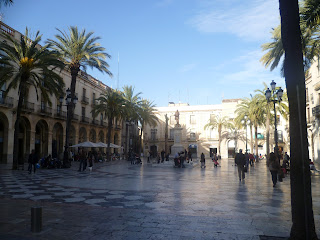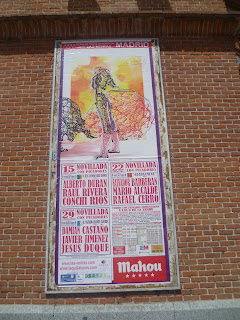After a horrendous eight hour train journey, I arrived in Madrid bright and early on Friday morning just after 7:30am.
Luckily, my friend Hannah (who I met during my semester in Aix-en-Provence) lives in the capital and was kind enough to let me freshen up and give me some well needed breakfast at her flat (bacon and eggs, yes!). The view wasn't a bad way to start the weekend either...
For the rest of the day we wandered around the capital to do some sightseeing including la Plaza Mayor, el Palacio Real and el Mercado de San Miguel to name but a few.
I'd also waited to have churros con chocolate until I was in Madrid after I saw a photo of Hannah with them, and it's safe to say I wasn't disappointed!
In the afternoon we relaxed with a few cañas, but, it was the night time when Madrid really came to life.
Remember in Spain, you don't go out and eat until around 9:30pm at the earliest!
After getting off the metro at Puerta del Sol (in central Madrid), we didn't have far to go to the Centro-Barrio district where there are plenty of tapas bars.
Walking around, one particular bar, La Zapatería, caught our eye by the food in the window so we decided to go in.
A crowded bar with a buzzing and friendly atmosphere, the variety of different shoes nailed to the wall was a nice touch which kept with the theme of the bar (la zapatería translates as shoe shop).
We ordered some freshly made sangria as we decided on what to eat, it all looked so good!
After about ten minutes of deliberation, we settled on a dish consisting of patatas, chorizo y morcilla (potato, chorizo sausage and black pudding)... all I can say is it was delicious and definitely worth the wait - ¡ qué bien !
La Zapatería
Victoria, 8
28012
Madrid
España
We went to another bar afterwards, but La Zapatería was definitely a great little find which I would eat at again.
If you're in the area and looking for some good food, you must visit here!
Saturday:
I spent saturday visiting similar places as I'd been to on Friday, as my friend Amelia hadn't arrived in Madrid until rather late on Friday night and had missed out on a few things.
However, there was plenty more to see such as la Catedral de Almundena, la Puerta de Toledo, el Palacio de Cibeles and la Puerta de Alcala.
The nicest place we visited on Saturday was el Parque del Retiro.
An expansive park which is clearly very popular with locals, and tourists alike.
The park used to be owned by the Spanish Monarchy until the late nineteenth century when it became public.
There are many hidden gems inside the park such as el Monumento a Alfonso XIII, el Estanque, el Palacio de Cristal and much, much more.

It is without doubt one of the nicest parks I've visited, and is a must do whilst in Madrid.
Later on Saturday night, we went back to a bar for tapas that Hannah had taken me to on Friday - La Casita.
She had told me it had become her local because of the great food and friendly staff. What more could you want really?
Once there, I could see why.
Hannah had spoken about a woman who worked there simply known as "Mama" and the barman Jesús who couldn't have been friendlier, and well, the tapas, especially the albóndigas ? ... quite possibly the best I've ever eaten, this is no exaggeration.
La Casita
Calle de Víctor Hugo, 5
28004
Madrid
España
Sunday:
As Sunday was our last day, we decided to get up reasonably early and make the most of it.
After breakfast we made our way over to El Rastro, the most famous open air flea market in Madrid which is held every Sunday and public holiday.
The term el rastro means "the trail", and it is believed there was an abattoir and tannery nearby, where the blood from the slaughtered cattle flowed down the street whilst being transferred from one to the other.
In the afternoon, we decided to visit la Plaza de Toros de las Ventas in the Salamanca district.
I've always wanted to see a corrida de toros, even though I am fully aware of the controversy which surrounds this stereotypical Spanish tradition, and it just so happened that there was a novillada that day.
Warning: The following photos show the phases of the corrida which some people could find upsetting.
One thing which surprised me was how little I actually knew about the event.
Firstly, in each corrida de toros there are three matadors, and six toros.
At the beginning all matadors, picadores and bandilleros enter the ring, and bow to the President of the Plaza de Toros, and the King, if he is there.
Tercio de Varas:
Initially the two assistants will enter the ring and goad the toro into making a number of passes. This is done to determine the health and agression of the animal whilst the matador observes from the side.
Next, the picadores (men on horseback with lances) enter the ring. The purpose of the riders is to manouver themselves so that they can make short cuts with their lances into the shoulder area of the toro to weaken, and tire it.
Tercio de banderillas:
Once the picadores have left the ring, it is the turn of the banderillos to face the toro.
These are assistants who attempt to have the toro charge them and at the last minute, going over the horns, plant the banderillas (barbs decorated with ribbon) into its shoulders.
Tercio muerte:
The final passage of the corrida is after entering the ring alone, the matador uses his muleta (red cape) to have the toro charge him in series of tandas (passes). The objective being that when the toro does so, the matador maintains a rigid pose and guides the toro around his body. Skilled matadors will do so in a way that the cape does not leave the ground.
As the toro tires, both through blood loss and exertion, the matador goes to his assistant for the killing sword. On a particular charge this will be driven over the horns, through the shoulder blades and directly into the aorta killing it dead.
This is known as la estocada.
Sometimes it may be necessary for the matador to stab the toro in the back of the head using a descabello (a type of sword) to kill it.
In very rare occasions, a coup de grace is given and a bandillero severs the spinal cord to minimise suffering.
Finally, the toro is dragged from the arena by horses, butchered then sold to high end restaurants.
Following the death of the toro the crowd reacts depending on how they judge the spectacle. A great deal of cheering and waving of white handkerchiefs could see the successful matador being awarded one of three prizes;
An ear
Two ears
or, the ultimate prize;
Two ears and the tail.
Should one matador have achieved two ears and the tail, he will be hoisted above the other two and leave through the puerta grande ("great door") and into the history books.
I can say I've been to a corrida de toros now, but, I can also say I would never go to one again.
I can appreciate the history, culture and tradition involved with the spectacle, as it is almost a dance between the matador in his traje de luces and the toro, a highly respected, wild animal.
However, as the death of the toro is inevitable, it is very hard to ignore to obvious torture and distress the animal must endure during the spectacle, before the final act is completed.
If you are contemplating going to a corrida de toros, I think you should be fully aware of what to expect beforehand.
Not to end the post negatively, I had a great weekend and would most definitely visit Madrid again in the future.
As the madrileños say...
¡ Hala Madrid !






















































